
Flavor Notes by Robert Rich: Food, Wine, Restaurants & Recipes
Local Food Topics
Home Winemaking
by Robert Rich, October 2003, for MV Voice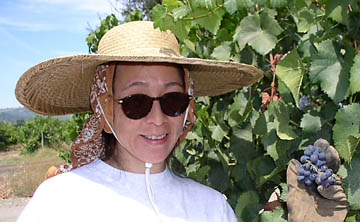
A few years ago, my friend Andrew Trice suggested a new way to get rid of the plums that messed up our back yards in July. He thought we might be able to make plum wine.
Plum wine sounded like a great idea, since I was getting a bit tired of making jam and chutney every year with our sticky harvest, jars from the past decade still filling our kitchen shelves.
We ventured over to Fermentation Frenzy, on San Antonio Road, to ask expert advice from Phil Montalbano. Phil set us up with some yeast starter, yeast food to keep the fermentation healthy, pectic enzyme to help dissolve the fruit, a five gallon glass jug and some air locks to allow gas to escape.
An invisible lever flipped in my mind as I realized I had just discovered another outlet for my obsessions with flavor, nature, alchemy and the sensual world: I caught the winemaking bug.
An Explosive Start
That first attempt at plum wine showed promise, and it showed that I needed to learn a lot about winemaking. The wine was so acidic I added sugar to make it tolerable. I didn't account for the effects of secondary fermentation, and half of my bottles exploded in the basement while I was away. I returned to find a very sticky mess.
To my amazement, the bottles that hadn't shot their corks turned into very good sparkling wine.
My next trial used an old winemaking kit that my wife had kept since the 1980's. That effort resulted in an odd but drinkable German-style Hockheimer. Heartened by the results, I jumped headlong into very inky water.
Fermentation Phil
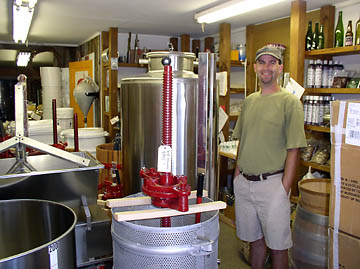
Back at Fermentation Frenzy, Phil patiently shared his advice and walked me through the equipment I would need to properly follow my crazy obsession. He recommended some books, taught me about an array of winemaking gadgets, and sold me additional glass storage jars (called carboys.)
Hobbyist brewers and winemakers visit Phil's shop frequently to ask advice, or sometimes just to say hello. He runs a challenging business, which requires teaching how to use almost every small purchase, and advising the proper steps and timing to make one's efforts pay off.
Fermentation Frenzy caters to all sorts of hobbyist fermenters, who make everything from beer and wine to vinegar, cheese, sourdough and soda pop. Most of Phil's customers make beer, buying ingredients like hops, barley, malt and yeast, and equipment like stainless steel boilers, hoses, valves, bottles, caps and capping tools.
Phil also helps judge home-brews at various small brewers' festivals, including the one that Mountain View hosted during the 1990's. Phil Montalbano's energy helps glue together the whole community of South Bay brewing enthusiasts.
By late summer, Fermentation Frenzy fills with winemaking gear, in anticipation of the harvest. Grape crushers, wine presses, oak barrels and fermentation tanks fill Phil's floor for the coming stampede of winemaking hobbyists like me. People can order grapes through the shop as well, and even help pick when the time comes, but I found my own source.
My First Big Steps
In late September 2002, I awoke at dawn and drove south to Paso Robles, where I had scored some zinfandel at Castoro Cellars. Every week I had been calling my friend Mikel, their assistant winemaker, asking when the grapes would be harvested.
A few wineries will tolerate the intrusion of hobbyists during the frenetic harvest season. I have learned to bring cash for the grapes, to lend a hand when needed, and to stand clear of big machines.
I filled three plastic barrels in the back of my van with fresh grape must pumped downhill from Castoro's crusher, 1200 lbs total costing $900. Three hours later later I returned home to figure how to get it into the basement.
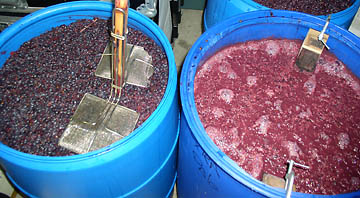
After four hours of bailing and hauling, I had my fermenters ready to innoculate with yeast. I got a bit nervous waiting two days for fermentation to start. Since then I have experimented with natural yeast fermentation, and I have become more patient; but this first time, I didn't know how long to wait. I used the Pasteur method, adding sulfite to kill wild flora before introducing more predictable breeds of yeast.
During fermentation I would occasionally push down the layer of grapes that rose to the top of the bubbling must, keeping the skins wet to prevent spoilage and to increase contact between grape and wine.
After a week, the yeast had digested most of the sugar, and bubbling had almost stopped: time to press. I returned to Fermentation Frenzy and rented a large basket press for $50.
I spent the afternoon hauling purple buckets upstairs to the press, then squeezing the young wine away from shrivelled skins and seeds. I siphoned the liquid back down to the basement, into three small used barrels that I had purchased from Ridge.
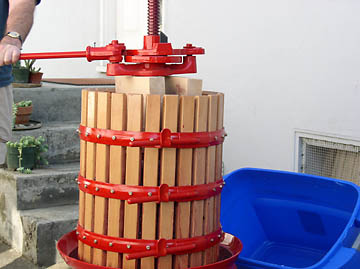
Then I learned more patience, as time did its work to soften the wine. Months passed as malolactic bacteria transformed the acids, and oak helped polymerize harsh tannins into long molecular chains that taste smoother.
In Spring, I added sulfite to protect the wine from foreign invaders, then siphoned it off the "lees", the sludge of dead yeast cells that lined the bottom of each barrel. For the next several months, I topped off the slowly evaporating barrels with excess wine, keeping them full to prevent oxidation.
A Lilliputian Jungle
A winemaker quickly learns the many little critters that can help or hinder all efforts at attaining perfection.
When I returned in late August from three months' travel, I ran down to the basement to check my wine. The tannins had softened, and the flavors had improved. However, I detected a subtle barnyard smell, like decaying grass, which probably came from a yeast called brettanomycin.
Furthermore, I feared that my wine would become over-oaked if I left it any longer on the toasted oak chips that I had added to the barrels. I decided to bottle as soon as possible.
In early September, I added more sulfite to the barrels to kill bacteria, then my wife and I stayed up until 5:30 AM bottling: sanitizing recycled bottles with sulfite solution, siphoning the ruby liquid from the barrels, then inserting fresh corks using an $80 corking machine purchased weeks prior from Fermentation Frenzy.
Forty cases of zinfandel soon filled the basement, now waiting more months for the oak to integrate. (I know what my friends are getting for Christmas this year.) Expenses reached about $5 per bottle, not counting free labor. If I consider the year's effort. . . well, I can buy better wine, but it wouldn't be mine.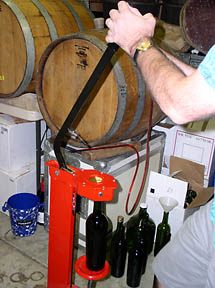
A Little Help from My Friends
Weeks after bottling, I taste last year's wine to convince myself that it still isn't awful. Some of my friends say they like it. I taste mostly my mistakes, the flaws that teach me how to make better wine this year. Still only a hobbyist, I'm a perfectionist trying to reach professional quality.
Vintners tend to share their knowledge generously. I owe many thanks to Castoro's Mikel Olsten, Ridge's Paul Draper and Eric Baugher, and Phil Montalbano at Fermentation Frenzy.
While great wine can reach the level of fine art, the act of winemaking brings it all down to earth. I have learned that good wine comes only from good grapes, and good vintners step aside while guiding wine to maturity. I'm still learning what this means in practice.
Postscript, 2006:
I'm still busy with winemaking, and managed to win a few awards in the meantime. The 2003 Cabernet that you see pictured fermenting above won double gold at the '04 Orange County home wine competition, and first place in Santa Cruz Mountains. The 2004 Traficanti Syrah also won gold in Orange county, and I have now been able to work with grapes from the same vineyards for several years in a row. That sort of repetition has allowed me to learn firsthand how the year-to-year weather variations affect the final wine, and how much the vineyard itself affects the character.
Phil Montalbano still works at his store, but recently sold the business to a growing Bay Area company called MoreBeer (and MoreWIne, MoreFlavor, more etc.) so the store name has changed to MoreFlavor.
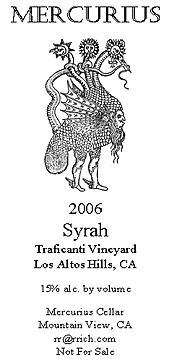
MoreFlavor
991 N. San Antonio Road
Los Altos, CA 94022
(650) 949-BREW
HOURS
Wed - Fri: 11:00 - 6:30
Sat: 11 - 5 Sun: 11 - 3
http://moreflavor.com/public/moreflavor/
email: philm@morebeer.com
(Photos of pressing and bottling by Dixie Chan.)